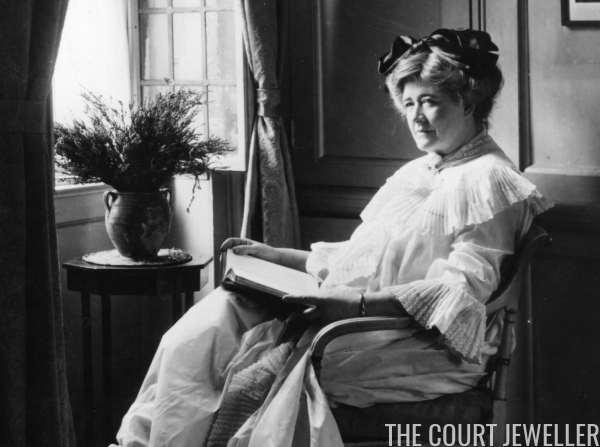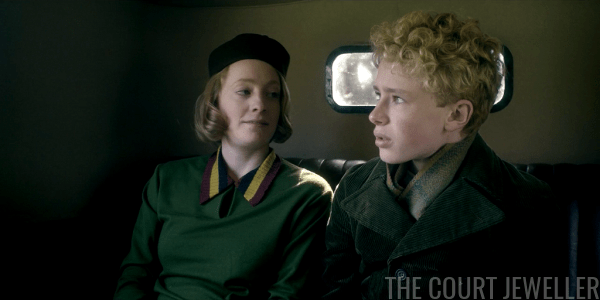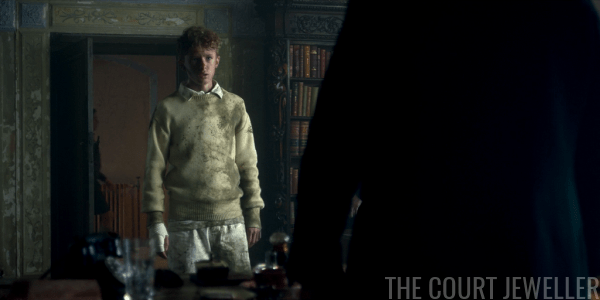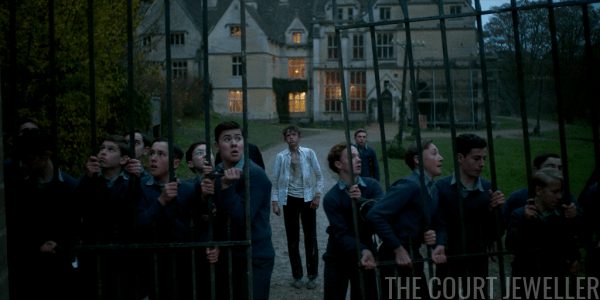 |
| Assisted by a doll named Arthur (whose sign reads “I am Arthur. Please help all us babies for our absent daddie’s sakes”), Lady Diana Manners and Lady Bonham Carter receive pieces for the Children’s Jewel Fund, March 1918 (Topical Press Agency/Getty Images) |
The eloquent appeal which was made on New Year’s Day on behalf of the Children’s Jewel Fund for starting more infant welfare centres throughout the country has had a remarkable response. Not only have magnificent tiaras, necklaces, pendants and other rich ornaments been sent by ladies of title to the Duchess of Marlborough [1] at 175 New Bond Street, but a number of personal relics and treasures have been received, which show the enthusiasm with which the movement has been taken up in all parts of the country.
“I have no jewels of any value,” a Lancashire lady wrote, “but I send this little pendant purchased years ago in very happy times at Granada in Spain. It has been valued at five guineas. I wish I had something better to send.” Miss Ellen Terry [2], one of the ten ladies who signed the appeal, has had sent to her half a sovereign mounted as a pendant. It was the last thing the mother of the donor gave her before she died.
 |
| Ellen Terry, one of Britain’s most respected Shakespearean actresses, sits for a photographic portrait, ca. 1905 (Hulton Archive/Getty Images) |
Some schoolgirls, who wrote to the Duchess to say they had no jewellery, sent a postal order for ten-and-sixpence. A young naval officer, who had no jewels but sleeve links, “and those,” he said, “I must keep,” sent half a sovereign. An eyeglass and a gold toothpick, which belonged to the author of “Miserimus” [3], have been sent by a lady with a ring, which was given to her mother by Lady Blessington [4]. A lady from Glasgow, who called at New Bond Street, was so full of enthusiasm that she promised on her return to Scotland to get all her friends to contribute jewels to the fund. In this case the proceeds are to be specially earmarked for the needs of Glasgow mothers and babies.
Lady Tree [5] has given a diamond pendant and a wedding ring which belonged to a friend who has died; Lady Jellicoe [6] two handsome bracelets; Lady Londonderry [7] a gold bracelet set with diamonds and rubies; Mrs. George Keppel [8] a diamond buckle; Mrs. Reginald McKenna [9] a watch and a long chain of blue enamel set with pearls and diamonds.
 |
| The Duchess of Marlborough wears a pearl dog-collar with diamond plaques, ca. 1902; you can read more about the tiara she wears in this coronation portrait in this post |
A pearl dog-collar with diamond plaques from the Duchess of Marlborough; a diamond tiara from the Countess of Essex [10]; a diamond bandeau from Lady Henry [11]; a pearl and diamond hair ornament from Lady Ward [12]; an antique diamond ring from Lady Bonham Carter [13]; a diamond and turquoise pendant from the Countess of Rocksavage [14]; a pearl and amethyst necklace from the Duchess of Rutland [15] are amongst other rare treasures which have been contributed to the fund. Already the list is so large that our space is too short to do.
It is curious to see how the gifts are sent. Some have come in their original morocco and silk lined boxes, almost as fine as the jewels themselves. Others have been sent in any old tin or box. A diamond ring which has been valued at 250 pounds was sent, for example, in an old matchbox. It does not matter how they come, or what they are, any gift, from a tiara to a wedding ring, is welcomed, and the donor will receive a card which she will be able to treasure a grateful acknowledgment from the Duchess of Marlborough.
As to the need of this fund Lady Henry said yesterday to a representative of the Observer that the greatest war work anyone can do is to help, by saving the babies, to replace the lives that have been sacrificed on the field of battle. The number of centres already established for the care of mothers and babies is not much more than a thousand. Five times this number are urgently needed.
 |
| The Duchess of Marlborough visits the Lighthouse Mission for Women and Orphans, February 1919 (Bloomfield/Topical Press Agency/Getty Images) |
Before any welfare centre was started at all the infant mortality rate in this country was as high as 145 per 1,000. That was ten years ago. With the thousand or so centres in existence the rate is now below one hundred. In New Zealand, where infant welfare has been placed on a more perfect basis than anywhere else in the world, the rate has declined from 100 to 50 per 1,000. It is clear, therefore, that infant welfare can save at least another half of the young lives that are now lost to the nation through avoidable causes.
Every woman is asked to do her part in this “the greatest war work” by contributing just one jewel to help start more of these urgently needed centres. To quote the words of the appeal, every woman is asked “to give of her best so that the pride and joy of another woman’s heart may be helped to strong and healthy life.”
NOTES
1. Consuelo Spencer-Churchill, Duchess of Marlborough (1877-1964), née Consuelo Vanderbilt, later Consuelo Balsan. The American-born duchess was one of the most stylish and famous women of her era. She had been separated from her husband since 1906, and they would divorce in 1921, three years after this article was published. Philanthropy remained a consistent part of her life; she went on to help found the Foch Hospital near Paris.
2. Ellen Terry (1847-1928) was one of Britain’s most important Shakespearean actresses. In 1918, she was still performing on stage, and had recently made her first appearance in film. She was also active in war relief efforts. She retired from acting in 1922, and in 1925, she was created a Dame Grand Cross of the Order of the British Empire.
3. Adah Isaacs Menken (1835-1868) was a famous American actress who also wrote and published poetry.
4. Marguerite Gardiner, Countess of Blessington (1789-1849), née Margaret Power, was an Irish writer and host of a famous literary salon.
5. Helen, Lady Tree (1863-1937), née Helen Maud Holt, was the widow of Shakespearean actor Sir Herbert Beerbohm Tree. She was also a noted actress in her own right, and she continued to appear on stage and in films until a few years before her death.
6. Lady Jellicoe (1877-1964), née Florence Cayzer, was the wife of Sir John Jellicoe, who was First Sea Lord from 1916 until January 10, 1918 (a few days after this article was published). Because of upgrades to her husband’s titles, Florence later became Viscountess Jellicoe and then Countess Jellicoe.
7. Edith Vane-Tempest-Stewart, Marchioness of Londonderry (1878-1959), née Edith Chaplin, was a granddaughter of the 3rd Duke of Sutherland and the wife of the 7th Marquess of Londonderry. She was active in relief work during the war, and she was made a Dame Commander of the Order of the British Empire in 1917 in recognition of her efforts.
8. Alice Keppel (1868-1947), née Alice Edmonstone, was married to the Hon. George Keppel, but she’s best known for being the mistress of King Edward VII. The present Duchess of Cornwall is Alice’s great-granddaughter.
9. Pamela McKenna (1889-1943), née Pamela Jekyll, was the wife of Reginald McKenna, a Liberal politician who had been Chancellor of the Exchequer from 1915 to 1916. Pamela was an important political and society hostess.
10. Adele Capell, Countess of Essex (1867-1922), née Adele Grant, was the American-born second wife of the 7th Earl of Essex. Her father was in locomotive manufacturing. Before her marriage to Lord Essex, Adele was engaged to another British aristocrat, the 2nd Earl Cairns. Widowed in 1916, she died only four years after this article was published.
11. Lady Henry (1872-1927), née Julia Lewisohn, was the American-born wife of Sir Charles Solomon Henry, 1st Bt. Sir Charles was an Australian-born politician who served as a member of parliament for more than a decade; he died the year after this article was published. Julia was dedicated to war work, especially after the death of her only child, Cyril, in the Battle of Loos in 1915.
12. Lady Ward (1884-1962), née Jean Templeton Reid, was the daughter of Whitelaw Reid, who served as the American ambassador to the Court of St. James from 1905 until 1912. In 1908, she married the Hon. Sir John Hubert Ward, the second son of the 1st Earl of Dudley. Sir John was also an equerry to four monarchs — King Edward VII, King George V, King Edward VIII, and King George VI — and the Wards were highly connected in British society.
13. Lady Bonham Carter (1887-1969), née Violet Asquith, was a daughter of Prime Minister Herbert Henry Asquith, who had served until 1916. She married Sir Maurice Bonham Carter, her father’s private secretary, in 1915; one of their grandchildren is the actress Helena Bonham Carter. Violet was an important political figure of her time, serving as president of both the Liberal Party and the Women’s Liberal Federation; she was also one of Winston Churchill’s closest friends. In 1964, she was granted a life peerage, becoming Baroness Asquith of Yarnbury.
14. Sybil Cholmondeley, Countess of Rocksavage (1894-1989), née Sybil Sassoon, later Marchioness of Cholmondeley, was the wife of the 5th Marquess of Cholmondeley. She was the sister of Sir Philip Sassoon, an important British art collector and politician. During World War II, Sybil was an important leader in the Women’s Royal Naval Service. Her great-grandson is the actor Jack Huston.
15. Violet Manners, Duchess of Rutland (1856-1937), née Violet Lindsay, was the wife of the 8th Duke of Rutland. She was a particularly talented artist, and she was also deeply involved in the war effort, turning her London home into a hospital. A recent book, The Secret Rooms, details her efforts to keep her only son away from the front during the war.













































